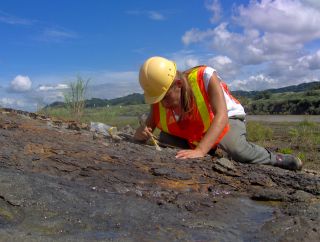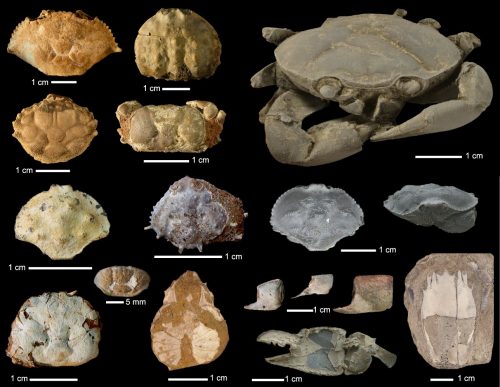By Javier Luque | University of Alberta, Canada, and STRI, Panama
I am a PhD student from Colombia, investigating the early origins of crabs, their phylogenetic relationships, and the evolution of their compound eyes. My thesis work at the University of Alberta aims to address major shortcomings in the understanding of crab evolution—one of the most diverse, abundant, and economically important groups of invertebrates.

Since I first started studying the fossil crustaceans of Panama in 2007, thousands of samples of more than 30 crab, shrimp, and barnacle species have been rescued in a constant race against time during the expansion of the Canal. Among the most remarkable findings are some previously unknown Eocene assemblages, and diverse Miocene faunules with mixed Caribbean and Pacific affinities.
The recent discovery of a Miocene freshwater crab from the Canal represents one of the oldest freshwater crabs worldwide. Its exceptional preservation, including that of its compound eyes, makes it the most complete fossil freshwater crab known to date. Although its generic identity is yet to be established, it belongs to a family endemic to the Tropical Americas, and future phylogenetic analysis might shed light on the dispersal of freshwater crab genera across the Isthmus during the Cenozoic.
Another exceptional find has been an assemblage of Holo–Pleistocene crabs scattered in a gravelly bay near the Pacific entrance of the Canal, and includes hundreds of large fossil fiddler crabs (Uca sp.), a Sally Lightfoot crab (Grapsus sp.), and a land crab (Cardisoma sp.).

Interestingly, these species are still living today, and are typically associated with estuarine settings along the Bay of Panama, indicating that not too long ago this gravelly bay was a large mudflat with fresh water influx and rocky shores home to a range of sub, inter, and supratidal crabs.
Currently, I am describing this fascinating material in collaboration with Roger Portell and Austin Hendy from the FLMNH, and putting together pieces of the large puzzle that is the marine biotic history before and after the Panama Isthmus uplift. I am deeply grateful to STRI and the PCP–PIRE Project for supporting my research in Panama and Florida, and to the several field assistants and researchers that have helped in the collections over the years. Documenting the fossil record of decapod crustaceans is crucial to our understanding of their relationships through common ancestry, and how different lineages have responded to global and local changes over time.
Por Javier Luque | Universidad de Alberta, Canada, y STRI, Panamá
Soy un estudiante de PhD de Colombia que investiga el origen de los cangrejos, sus afinidades filogenéticas y la evolución de sus ojos compuestos. Mi trabajo de tesis trata de responder algunas interrogantes sobre la evolución de los cangrejos—uno de los grupos de invertebrados más diversos, abundantes y económicamente importantes.

Desde que comencé a estudiar los crustáceos fósiles de Panamá en el 2007, miles de muestras de más de 30 especies de cangrejos, camarones y percebes han sido rescatadas en una constante carrera contra el tiempo durante la expansión del Canal. Entre los hallazgos más notables se encuentran algunas colecciones del Eoceno previamente desconocidas, así como diversas faúnulas Miocenas con afinidades del Caribe y del Pacífico.
El reciente descubrimiento de un cangrejo de agua dulce en rocas del Mioceno del Canal representa uno de los cangrejos dulceacuícolas más antiguos del mundo. Su preservación excepcional, incluyendo sus ojos compuestos, hace de este ejemplar el fósil de cangrejo de agua dulce mas completo hasta la fecha. Aunque su identidad genérica necesita ser establecida, esta especie pertenece a una familia endémica de las Américas Tropicales, y futuros análisis filogenéticos podrán dar pistas sobre la dispersión de los cangrejos dulceacuícolas a través del Istmo durante el Cenozoico.
Otro hallazgo excepcional es una asociación de cangrejos Holo–Pleistocenos esparcidos en una bahía de grava cerca de la entrada Pacífica del Canal, e incluye cientos de fósiles de cangrejos violinistas (Uca sp.), un cangrejo de las rocas (Grapsus sp.), y un cangrejo terrestre (Cardisoma sp.).

Lo interesante es que estas especies aún viven hoy en día, y están particularmente asociadas con estuarios a lo largo de la Bahía de Panamá, lo que indica que no mucho tiempo atrás esta bahía rocosa fue una playa lodosa con afluencia de agua dulce, y hogar de varias especies de cangrejos sub, inter, y supramareales.
Actualmente me encuentro describiendo este fascinante material en colaboración con Roger Portell y Austin Hendy del FLMNH, y estamos poniendo juntas algunas piezas de este gran rompecabezas que es la historia de la biota marina antes y después del levantamiento del Istmo de Panamá. Gracias al STRI y el Proyecto PCP–PIRE por apoyar mi investigación en Panamá y Florida, y a muchos asistentes de campo e investigadores que han ayudado en las colecciones a través de los años. Documentar el registro fósil de los crustáceos decápodos es crucial para expandir nuestro conocimiento sobre sus relaciones ancestro-descendiente, y comó diferentes linajes han respondido a cambios globales y locales a través del tiempo.